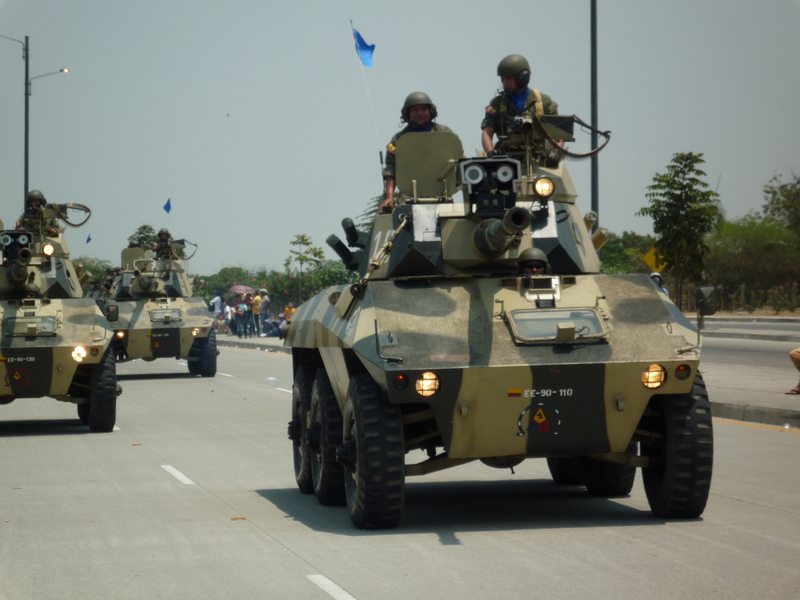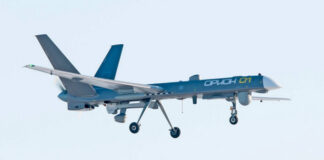A well-known wheeled reconnaissance vehicle from Brazil, the ENGESA EE-9 Cascavel, manufactured by Engesa.
Introduce
Launched in the early 1970s, the EE-9 Cascavel was designed to replace the outdated Brazilian fleet of M8 Greyhound. EE-9 Cascavel is known as a successful Brazilian export product. It is the most numerous cannon armed reconnaissance vehicles. Due to its powerful weapon, it can also serve as a fire support vehicle.
Besides the Cascavel, was also produced the Urutu, which shares with Cascavel largely of mechanical components, although it is actually con vehicle uses completely different. Both entered production in 1974 and are now operated by over 20 nations in South America, Africa, and the Middle East.
Rights to the design were also sold to the United States via the FMC Corporation. About 2,767 Cascavels and Urutus were manufactured before Engesa ceased operations in 1993.

Throughout the early 1960s, Brazil’s bilateral defence agreements with the United States ensured easy access to a postwar surplus of American military equipment, including a number of World War II-vintage M8 Greyhound armoured cars.
The Brazilian arms industry limited itself to restoring and maintaining this obsolete hardware until 1964, when American involvement in the Vietnam War placed restrictions on the amount of defence technology available for export.
Brazil responded by creating an indigenous import substitution programme in 1968 aimed at reproducing US equipment already in service. Cascavel Design work started in July 1970 and ten vehicles were delivered between 1972 and 1973, with more production vehicles delivered in 1974.
Design
The first production Cascavel, vehicles were armed with 37 mm guns taken out of old M3 Stuart light tanks, and the first export vehicles were armed with a H90 turret produced by CNMP-Berthiez of France. Later production vehicles had a new Brazilian designed turret carrying a Belgian 90mm Cockerill Mk.3 cannon produced under licence as the EC-90 in Brazil.
All EE-9 Cascavels layout are based on the World War 2 era US M8 Greyhound scout car. A boxy, boat-shaped vehicle, the EE-9 Cascavel has a steep frontal glacis which slopes upwards and back towards the horizontal hull roof, with recesses for the headlamps and a thick glacis plate over the driver’s seat.

The hull sides are nearly vertical, but also sloped inwards towards the roof. There is a low, well-rounded turret on the forward section of the hull with a long, tapered gun barrel and a triple baffle muzzle brake.
The EE-9 uses a similar 6×6 wheelbase with boomerang suspension for the rear wheels. The crew of three consists of a driver, seated in the front of the hull, and a commander and gunner who seated in the turret. The engine is mounted at the rear of the vehicle.
Armament
The dual hardness steel armor protects the EE-9 from 12.7mm rounds over the frontal arc and small arms fire and shell splinters all around. An NBC system is not fitted. Six smoke grenade launchers are attached to the turret.
The Cascavel Mk II has a manual turret, but all later variants have electrically powered traverse. Cascavel Mk IIIs are equipped with an Engesa EC-90 90mm gun firing high explosive, high explosive anti-tank or high explosive squash head shells in cartridge form; a coaxial 7.62mm machine gun is also mounted to the left of the main armament.
The EC-90 has an elevation of +15° and a depression of -8°. It is not stabilised and only mounts a rudimentary optical fire control system, which has been upgraded with a laser rangefinder in Brazilian service. Late production Cascavels were fitted with run-flat tyres and a unique central tyre pressure regulator accessible from the driving compartment.
The EE-9 armored reconnaissance vehicle has a rather powerful armament and can be also used for direct fire support or destroy hostile armored vehicles. The Cascavel can easily destroy various armored personnel carriers, infantry fighting vehicles, and other armored vehicles except main battle tanks.

Performance
Brazil still maintains its Cascavels for reconnaissance duties, with the biggest operational park today, of around 600 vehicles. Like other vehicles of the same type, the Cascavel compensates for its lack of armor with very good mobility, having a top speed of 110 km/h. Still in service in several countries and currently runs a program to modernize the EE-9, as well as the EE-11, enabling them to remain in service for some time.
Operation history
The Cascavel was well tested in combat. The Iraqi Cascavels were especially numerous in Saddam’s arsenal by 1991, with 400 vehicles in service. However, they were never paid for due to the US invasion, creating a net loss of $200 million for its manufacturer.
Many were destroyed during the Iran-Iraq war, in Operation Desert Storm, and later during the Iraqi war in 2003, but surviving vehicles are still in service with the new Iraqi Army. Their armor could not cope with Armor-piercing rounds fired by the standard-issue 25 mm autocannons of the Bradley and LAV-25.

The second largest park of vehicles was acquired by Libya with 500 vehicles, largely used in the Chadian–Libyan conflict. The Chadians managed to capture five vehicles, which are no longer in service. Libyan Cascavels were also well-used in the Libyan civil war. Other operational uses include the Second Congo War, the internal conflict in Burma, and Colombian civil war.
Brazil is the main user of the EE-9. Many have been exported to South America, Africa and the Middle East. The EE-9 is not used by Western nations, except for Cyprus.
No oher Brazilian armored vehicle ever had such success on the international market. Relatively simple and affordable, the EE-9 Cascavel came as a solution for emerging local powers to secure a fast response vehicle suited for flat, dry expanses where armored cars are more at ease than tanks.
Thank you for visiting Military-wiki.com. I’m Dung Tran, the person behind all this content. I know some websites are copying my articles. Stop this, or at least respect me by citing the source from Military-wiki.com. Thank you.























